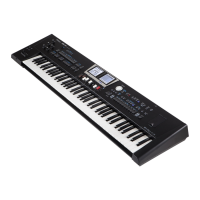Listening Through Headphones
21
• When connection cables with resistors are used, the volume level
of equipment connected to the INPUT jacks may be low. If this
happens, use connection cables that do not contain resistors.
Listening Through Headphones
You can use headphones to enjoy the BK-9 without disturbing
those around you, such as at night.
1. Plug the headphones into the PHONES jack located on the
BK-9’s front panel.
2. Use the BK-9’s [VOLUME] knob to adjust the headphone
volume.
Cautions when using headphones
• To prevent damage to the cord’s internal conductors, avoid rough
handling. When using headphones, mainly try to handle either the
plug or the headset.
• Your headphones may be damaged if the volume of a device is
already turned up when you plug them in. Minimize the volume
before you plug in the headphones.
• Excessive input will not only damage your hearing, but may also
strain the headphones. Please enjoy music at a reasonable volume.
Connecting a Microphone
1. Turn the [VOLUME] knob all the way to the left to
minimize the volume.
2. Connect your microphone to the MIC IN jack.
3. Use the BK-9’s [VOLUME] knob to adjust the volume.
4. Use the BK-9’s [MIC VOLUME] knob to adjust the
microphone audio level.
Please set the Phantom switch on the rear of BK-9 according to your
microphone type.
NOTE
To avoid damaging of external audio system, turn the [VOLUME]
knob all the way to the left to minimize the volume before set
the Phantom switch.
Phantom +48V
Switch
Explanation
O
Dynamic Mic: 1/4“phone plug (balanced or unbalanced), XLR
connector.
On
Condenser Mic: XLR connector (48 V phantom power supported)
* If you don’t need phantom power supply, select the OFF
position.
NOTE
This instrument is equipped with balanced (XLR and 1/4” phone)
type jacks. Wiring diagrams for these jacks are shown below.
Make connections after rst checking the wiring diagrams of
other equipment you intend to connect.
MEMO
The BK-9 provides an equalizer you can set for the MIC IN jack.
See “Mic Settings” (p. 144).
NOTE
Howling could be produced depending on the location of
microphones relative to speakers. This can be remedied by:
1. Changing the orientation of the microphone(s).
2. Relocating microphone(s) at a greater distance from speakers.
3. Lowering volume levels.

